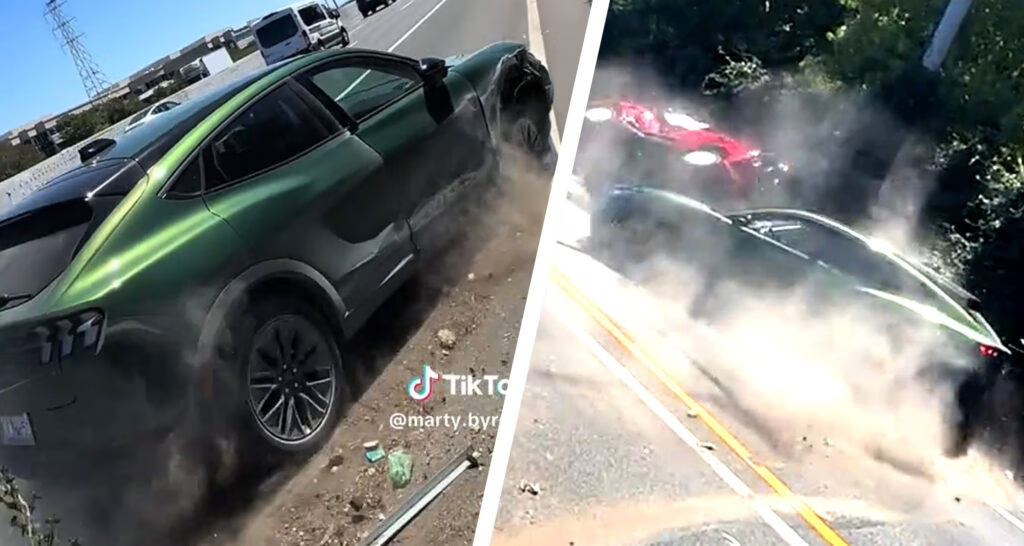What Really Happened in the Mustang Mach-E Highway Crash Caught on Video?
If you’ve seen the viral TikTok clip of a green Ford Mustang Mach-E scraping along a Bay Area highway wall, hazard lights flashing, you probably have questions. Why was the driver’s hands off the wheel? Was it a tech failure, a medical emergency, or something else entirely? Let’s break down what’s known, what’s still a mystery, and what this incident reveals about modern driving.
Why Did the Mustang Mach-E Driver Take Their Hands Off the Wheel?
The footage shows the Mach-E driver with both hands raised, seemingly in distress—some viewers even say it looked like they were praying. It’s not the typical image of someone fighting to regain control. This detail has sparked a wave of speculation online. Was the driver experiencing a medical episode, panic, or something more mechanical?
According to the National Highway Traffic Safety Administration (NHTSA), sudden incapacitation—like fainting or seizures—accounts for a small but real percentage of crashes each year. But there’s also the possibility of driver confusion or even a tech-related issue. With advanced driver assistance systems like Ford’s BlueCruise, some drivers may mistakenly believe the car can handle emergencies on its own, leading to hesitation or inaction when things go sideways.
Could the Crash Have Been Caused by a Vehicle Malfunction?
Here’s where things get murky. The Mach-E was seen scraping the wall before veering into a red Mitsubishi Mirage, causing it to roll over. Both drivers, thankfully, walked away without serious injuries. But why didn’t the Mach-E stop or steer away?
Modern electric vehicles like the Mach-E are designed with multiple safety redundancies. Even if a driver assistance system malfunctions, the brake and steering should still respond to manual input. Ford’s BlueCruise, for example, is supposed to disengage if the driver grabs the wheel or presses the brake. The fact that neither seemed to happen raises questions. Was there a rare mechanical failure? Did the driver freeze up? Or was the car’s emergency braking system simply too slow to react?
According to a 2023 Insurance Institute for Highway Safety (IIHS) report, advanced driver assistance systems can reduce certain types of crashes by up to 50%, but they’re not foolproof. There have been documented cases where sensors fail to detect obstacles or where software glitches prevent timely intervention. However, a total loss of steering and braking is extremely rare and would likely trigger a recall or investigation.
What Should Drivers Do If Their Car’s Tech Fails on the Highway?
Let’s get practical. If you ever find yourself in a runaway vehicle—whether due to tech failure or another emergency—there are steps you can take. Experts recommend:
– Firmly pressing and holding the brake pedal. In most cars, this will override cruise control or driver assistance features.
– Shifting into neutral, which disconnects the engine or motor from the wheels.
– Using the parking brake in short, controlled bursts if the main brakes don’t respond.
– Steering toward a safe area, even if it means scraping a barrier to slow down.
It’s also worth noting that most EVs, including the Mach-E, have manual overrides for their electronic systems. If you’re driving a car with advanced tech, take a few minutes to read the emergency procedures in the owner’s manual. It could make all the difference.
Why Didn’t the Mach-E’s Emergency Braking System Activate?
This is the million-dollar question. Automatic emergency braking (AEB) is standard on most new vehicles, and it’s designed to detect imminent collisions and apply the brakes if the driver doesn’t react. Yet, in this case, the Mach-E kept moving after hitting the wall and didn’t stop before colliding with the Mirage.
AEB systems rely on radar, cameras, and sometimes lidar to sense obstacles. If sensors are blocked, dirty, or damaged (say, by scraping a wall), the system might not work as intended. There’s also a split-second delay between detection and action—sometimes, that’s all it takes for a crash to happen anyway.
A 2022 study from the European New Car Assessment Programme (Euro NCAP) found that AEB systems successfully prevented rear-end crashes in 85% of test scenarios, but performance dropped in complex situations like merging traffic or when vehicles approached at odd angles. In other words, the tech is good, but not infallible.
How Did Bystanders and Social Media React?
The TikTok video, posted by user Marty.Byrde3, quickly racked up over half a million views. Commenters were equal parts baffled and relieved that no one was seriously hurt. Some speculated about a stuck accelerator or a software bug. Others focused on the human side—wondering if the driver was overwhelmed, sick, or simply panicked.
This kind of viral attention isn’t just internet rubbernecking. It puts real pressure on automakers and regulators to investigate and, if necessary, improve safety features. Ford has reportedly been contacted for comment, and incidents like this often prompt internal reviews or even formal investigations by agencies like the NHTSA.
What Can We Learn About the Future of Driving from This Crash?
Incidents like the Mach-E crash are a wake-up call. As cars get smarter, the line between human and machine control gets blurrier. Most drivers aren’t tech experts—they just want to get from A to B safely. But as vehicles take on more responsibility, it’s crucial for drivers to understand both the capabilities and the limits of their car’s systems.
The big takeaway? Safe driving in the age of automation isn’t about perfection—it’s about smarter adjustments. Start with one change this week—maybe reviewing your car’s emergency features or practicing a manual override—and you’ll likely spot the difference by month’s end. Stay curious, stay prepared, and remember: even the smartest car still needs a human at the wheel.

